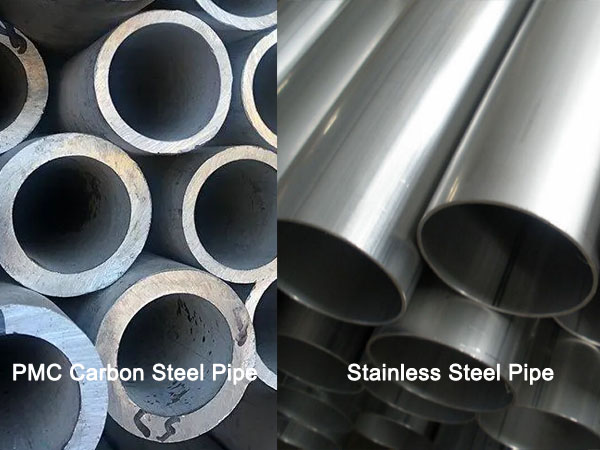
Carbon Steel Pipe vs Stainless Steel Pipe: Material Difference and Applicable Scene Analysis
Date:2023-07-12 keywords: carbon steel pipe vs stainless steel pipe, carbon steel vs stainless steel
In today's industrial field, carbon steel pipe and stainless steel pipe are one of the most commonly used piping products. Although they are both used to transport gases and liquids, their materials vary widely. This article will conduct a detailed analysis of the material differences and applicable scenarios of carbon steel pipes & tubes (CS pipe) and stainless steel pipes (SS pipe) from four aspects.
1. Chemical composition
The main components of carbon steel pipe are carbon and iron, containing 1.5% carbon. The main components of stainless steel pipes are iron, chromium, nickel and a small amount of carbon. Therefore, stainless steel pipes not only have the mechanical properties of ordinary steel, but also have good corrosion resistance.
2. Mechanical properties
In terms of mechanical properties, there are also certain differences between carbon steel pipes and stainless steel pipes. Carbon steel pipes have higher strength and hardness, so they are better suited than stainless steel pipes for applications in high pressure and high temperature environments. Stainless steel pipes are weaker in terms of strength and hardness, but are more ductile and corrosion-resistant than carbon steel pipes.
3. Cost and maintainability
From a cost and maintainability point of view, carbon steel pipes have a cost advantage over stainless steel pipes because their raw materials and manufacturing costs are lower than stainless steel pipes. In addition, carbon steel pipes are also easier to maintain and replace due to lower repair costs and ease of machining.
Stainless steel pipe is more difficult to machine and repair, so it is more expensive to manufacture and repair than carbon steel pipe. In addition, the differences between different types of stainless steel pipes are also large, and the selection and installation of stainless steel pipes need to be considered more carefully.
4. Applicable scenarios
In terms of applicable scenarios, there are also obvious differences between carbon steel pipes and stainless steel pipes. Due to its high strength and hardness, carbon steel pipes are usually used in the following scenarios:
Conveying high temperature and high pressure fluids
As a load-bearing member of a building
As the skeleton of steel structures and cars
Ventilation ducts for buildings and ducts for air handling systems
Stainless steel pipes are usually more widely used in the following scenarios:
Chemical Industry
Pharmaceutical Industry
marine industry
food processing industry
This is because stainless steel pipes have better corrosion resistance and toughness, and can withstand harsher environments.
In conclusion:
To sum up, there are certain differences between carbon steel pipes and stainless steel pipes in terms of material, mechanical properties, cost, and applicable scenarios. Therefore, we should choose the most suitable pipeline product according to the specific application scenario. Of course, when choosing pipeline products, we should not only consider our own needs, but also pay attention to factors such as corrosion and pressure that pipeline products may face, so as to ensure the safety and long-term use of pipelines.
1. Chemical composition
The main components of carbon steel pipe are carbon and iron, containing 1.5% carbon. The main components of stainless steel pipes are iron, chromium, nickel and a small amount of carbon. Therefore, stainless steel pipes not only have the mechanical properties of ordinary steel, but also have good corrosion resistance.
Due to the difference in their chemical composition, carbon steel pipes have higher strength and hardness, while stainless steel pipes have better corrosion resistance. Therefore, their performance differences are obvious in their respective domain-specific applications.

2. Mechanical properties
In terms of mechanical properties, there are also certain differences between carbon steel pipes and stainless steel pipes. Carbon steel pipes have higher strength and hardness, so they are better suited than stainless steel pipes for applications in high pressure and high temperature environments. Stainless steel pipes are weaker in terms of strength and hardness, but are more ductile and corrosion-resistant than carbon steel pipes.
3. Cost and maintainability
From a cost and maintainability point of view, carbon steel pipes have a cost advantage over stainless steel pipes because their raw materials and manufacturing costs are lower than stainless steel pipes. In addition, carbon steel pipes are also easier to maintain and replace due to lower repair costs and ease of machining.
Stainless steel pipe is more difficult to machine and repair, so it is more expensive to manufacture and repair than carbon steel pipe. In addition, the differences between different types of stainless steel pipes are also large, and the selection and installation of stainless steel pipes need to be considered more carefully.
4. Applicable scenarios
In terms of applicable scenarios, there are also obvious differences between carbon steel pipes and stainless steel pipes. Due to its high strength and hardness, carbon steel pipes are usually used in the following scenarios:
Conveying high temperature and high pressure fluids
As a load-bearing member of a building
As the skeleton of steel structures and cars
Ventilation ducts for buildings and ducts for air handling systems
Stainless steel pipes are usually more widely used in the following scenarios:
Chemical Industry
Pharmaceutical Industry
marine industry
food processing industry
This is because stainless steel pipes have better corrosion resistance and toughness, and can withstand harsher environments.
In conclusion:
To sum up, there are certain differences between carbon steel pipes and stainless steel pipes in terms of material, mechanical properties, cost, and applicable scenarios. Therefore, we should choose the most suitable pipeline product according to the specific application scenario. Of course, when choosing pipeline products, we should not only consider our own needs, but also pay attention to factors such as corrosion and pressure that pipeline products may face, so as to ensure the safety and long-term use of pipelines.
News Update :
Schedule 40 vs. Schedule 80 Pipe Pressure Rating...
©2017 Permanent Steel Manufacturing Co.,Ltd https://www.permanentsteel.com All Rights Reserved.
Terms of Sale|Privacy Policy


